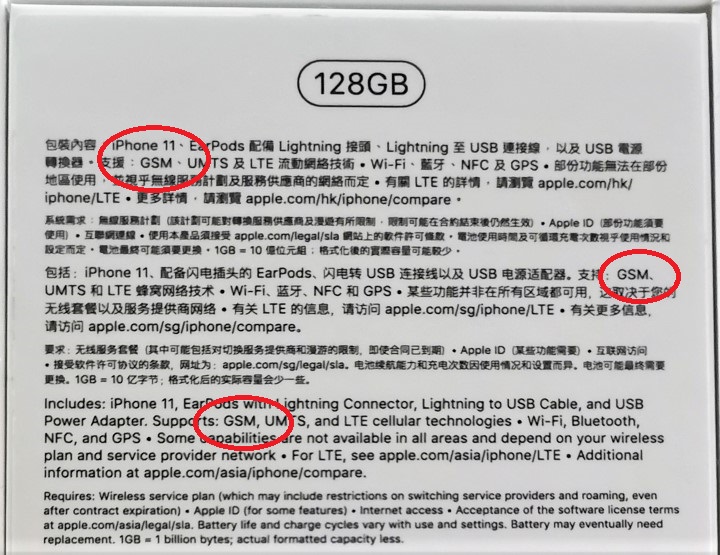Apple’s new iPhone 11 units are yet to arrive in the Philippines officially. Those who can’t wait for the local availability opted to buy in other countries like Singapore and Hong Kong, where it’s nearest. However, you have to take note of the model’s LTE bands as not all iPhone units support the LTE bands in the Philippines. Here’s how to check before buying.
The quickest way to find out if the iPhone 11, iPhone 11 Pro, or iPhone 11 Pro Max, support LTE Band 28 (700MHz) is to look at the model number and cross-check it with Apple’s list online. You can do that by checking the back of the box. It starts with the letter A followed by four numbers. Also, check if it’s a GSM model. Check the photos below.


If you have already bought it, just go to Settings -> General -> About. In this case, the iPhone 11 we bought in Singapore has a model number A2221 (GSM). Basically, you just have to look for these iPhone 11 model numbers that support LTE Band 28:
• iPhone 11: A2221 (GSM)
• iPhone 11 Pro: A2215 (GSM)
• iPhone 11 Pro Max: A2218 (GSM)
Alternatively, you can go to www.apple.com/iphone/LTE/ 561 and search for the model number. Once you found the model number, you should see a list of LTE bands beside it. If you see Band 28, then your unit is good. The only iPhone 11, iPhone 11 Pro, or iPhone 11 Pro Max units that don’t have LTE Band 28 are those that are sold in the United States, China, and Hong Kong, so stay away from those units if you need the said band.
And that’s it. We hope that this guide helped you pick the right market to buy the new iPhones that support LTE Band 28.

YugaTech.com is the largest and longest-running technology site in the Philippines. Originally established in October 2002, the site was transformed into a full-fledged technology platform in 2005.
How to transfer, withdraw money from PayPal to GCash
Prices of Starlink satellite in the Philippines
Install Google GBox to Huawei smartphones
Pag-IBIG MP2 online application
How to check PhilHealth contributions online
How to find your SIM card serial number
Globe, PLDT, Converge, Sky: Unli fiber internet plans compared
10 biggest games in the Google Play Store
LTO periodic medical exam for 10-year licenses
Netflix codes to unlock hidden TV shows, movies
Apple, Asus, Cherry Mobile, Huawei, LG, Nokia, Oppo, Samsung, Sony, Vivo, Xiaomi, Lenovo, Infinix Mobile, Pocophone, Honor, iPhone, OnePlus, Tecno, Realme, HTC, Gionee, Kata, IQ00, Redmi, Razer, CloudFone, Motorola, Panasonic, TCL, Wiko
Best Android smartphones between PHP 20,000 - 25,000
Smartphones under PHP 10,000 in the Philippines
Smartphones under PHP 12K Philippines
Best smartphones for kids under PHP 7,000
Smartphones under PHP 15,000 in the Philippines
Best Android smartphones between PHP 15,000 - 20,000
Smartphones under PHP 20,000 in the Philippines
Most affordable 5G phones in the Philippines under PHP 20K
5G smartphones in the Philippines under PHP 16K
Smartphone pricelist Philippines 2024
Smartphone pricelist Philippines 2023
Smartphone pricelist Philippines 2022
Smartphone pricelist Philippines 2021
Smartphone pricelist Philippines 2020
poche says:
So whats the advantage of band 28 considering both telcos – globe and smart have at least 3 other bands that is being used by them for lte/4g and supported by the usa and china/hk models?
The hk/china model have dual physical nano simslot though so its a nice tradeoff for band 28 since globe and smart have band 1,3,5,7,41 between them.
Abe Olandres says:
700Mhz is faster and penetrates denser population
aljon says:
Band 28 is good for coverage and indoor signal penetration which can help you in certain areas and buildings. In some areas, it also is faster. It’s also good additional band for LTE carrier aggregation with FDD bands 1 and 3 (along with its theoretical upload speed advantage compared to TDD bands)
Kristoff says:
Hello Yugatech, let’s say my iPhone don’t have LTE Band 28 (700MHz) as I got it from US. Magwo-work pa din ba and what will be its adverse effect if I used it sa Smart or Globe network? Thanks in advance.
Abe Olandres says:
Yes it will.
Gian says:
Same question here. Would it work okay here in the Philippines? Thanks Yugatech!
Joshua says:
What are the down sides of having an iphone 11 not supporting band 28 (700)???
Mark martinez says:
Hi! Great topic. Is the LtE band the inly thing to worry? I mean how about 2g 3g network will there be no problems as well if te band 28 is compatible?